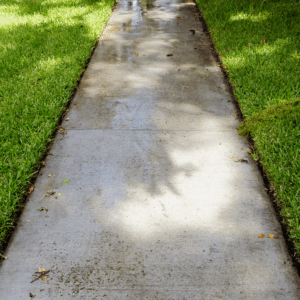
Uneven sidewalks are a hazard for homeowners, family members, and the general public. It’s essential to keep your sidewalk level and in good repair to prevent accidents and injuries. Anyone who needs sidewalk leveling can take a few steps to fix it so that it sits level once more and reduces the risk of incidents around the home and neighborhood.
The Dangers of an Uneven Sidewalk
Consider that sidewalks are frequently used by those who walk, run, or take their family for bike rides or a stroll. When there are uneven places on the sidewalk, it leads to trips and falls from unsuspecting foot and bike traffic. These falls and accidents can cause severe injuries to the individual. People of all ages, especially the elderly and small children, are at risk when there are uneven sections of the sidewalk. In fact, it may be the homeowner’s job to ensure the sidewalk stays in good repair in some areas. Keep reading to find out why sidewalks become uneven and how to level a sidewalk.
What Causes Uneven Sidewalks?
There are many reasons why a sidewalk may become uneven and start to crumble. One of the biggest culprits is erosion from the elements. Over time, rainfall and saturated soil allow the concrete to become brittle and break apart. The dirt underneath may also begin to erode and cause the sidewalk to crack and fall in sections.
Sidewalk Leveling; How to Fix an Uneven Sidewalk
So, what can you do if you have any issues with an uneven sidewalk? Perhaps the most cost-effective and straightforward solution is using sidewalk leveling foam. The process of leveling a sidewalk is straightforward. Still, if you have limited experience with tools or cannot perform the process yourself, you can hire a professional to do the job. They can get it done quickly and with a high degree of satisfaction in most instances.
The first thing you need to do to begin working on the leveling process is to acquire a drill with a drill bit that can create 5/8″ holes in the concrete. A few for each section should be sufficient. Once you complete the process of drilling the holes, you can use the sidewalk foam. Inject it into the holes, and it will go to work filling in the gaps and leveling the sidewalk. This process is faster, cheaper, and easier than removing the sidewalk section and reporting concrete in the space.
Get Fast Sidewalk Leveling Today
If you begin to notice the sidewalk becoming uneven around your home, you should take action immediately to prevent accidents. Some handy individuals may choose to tackle the project themselves, but most people are busy or don’t have the time or means to do it themselves. That’s why you should contact a professional sidewalk leveling company in your area. There’s no need to tackle this type of project when you can turn to a reliable and experienced local company that can quickly get the job done to have peace of mind.


Recent Comments